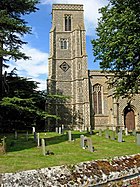Stowlangtoft
| Stowlangtoft | |
|---|---|
 Church of St George | |
Location within Suffolk | |
| Population | 270 (2005)[1] 228 (2011)[2] |
| District | |
| Shire county | |
| Region | |
| Country | England |
| Sovereign state | United Kingdom |
| Post town | Bury St Edmunds |
| Postcode district | IP31 |
| Police | Suffolk |
| Fire | Suffolk |
| Ambulance | East of England |
Stowlangtoft is a village and civil parish in the Mid Suffolk district of Suffolk in eastern England two miles south-east from Ixworth. Located around five miles north-east of Bury St Edmunds, in 2005 its population was 270.[1]
Name
[edit]The village, originally just Stow, was held by the de Languetot family in the early 13th century.[3]
St George's Church
[edit]For all of Stowlangtoft's small size, St George's is within the group classed as "Great Churches". Simon Jenkins included it in his book England's Thousand Best Churches.[4] The church was built as a single construction project in the late 14th century and barely changed until the restoration work undertaken in the 19th century. The church is in the decorated and later English styles; the chancel contains several richly-carved stalls and monuments to members of the family of D'Ewes.[5] The church and parsonage-house are located on what was once the site of a Roman encampment.[5] Peter Tillemans, one of the founders of the English school of sporting painting, was buried in St George's on 7 December 1734.[6]
Samuel Rickards was rector here for several decades in the mid nineteenth century.[4]
At some point after the Dissolution of the monasteries, St George's acquired six 14th-century misericords. It is not clear where these misericords originated, but possible candidates are Thetford Priory or Bury Abbey.[7]
Stowlangtoft Hall
[edit]
Sir Symonds D'Ewes, Bart., the eminent antiquary, lived in Stowlangtoft Hall.[5] The Hall was rebuilt in 1859 for Fuller Maitland Wilson.[8]
In 2011 a gruesome-looking tree in the grounds the hall attracted public attention.[8]
Notable residents
[edit]- Thomas Rawlinson, Lord Mayor of London in 1753
- Charles Wombwell, cricketer
- Frank Chapman, priest and Archdeacon of Sudbury
- Fuller Maitland Wilson (MP),
- Henry Fuller Maitland Wilson, army officer, son of Fuller Maitland Wilson
- Samuel Rickards, clergyman, opponent of the Oxford Movement
- D'Ewes baronets
References
[edit]- ^ a b Estimates of Total Population of Areas in Suffolk Archived 2008-12-19 at the Wayback Machine Suffolk County Council
- ^ "Civil Parish population 2011". Neighbourhood Statistics. Office for National Statistics. Retrieved 28 August 2016.
- ^ Ekwall, Eilert The Concise Oxford Dictionary of English Place-Names (4th ed., 1960) p. 448
- ^ a b Knott, Simon. "St George, Stowlangtoft". www.suffolkchurches.co.uk. Simon Knott. Retrieved 6 December 2021.
- ^ a b c Stoven - Stowick, A Topographical Dictionary of England (1848), pp. 234-38 british-history.ac.uk, accessed 17 April 2009
- ^ Noakes, Aubrey, Sportsmen in a Landscape (Ayer Publishing, 1971, ISBN 0-8369-2005-8), pp. 47–56: Peter Tillemans and Early Newmarket at books.google.com, accessed 7 February 2009
- ^ Suffolk Churches website, entry for Stowlangtoft, accessed 7 February 2013
- ^ a b Thewlis, Jo (14 June 2011). "Bury St Edmunds: Is the world's scariest tree lurking right here in Suffolk?". East Anglian Daily Times. Archant. Retrieved 6 December 2021.
External links
[edit]![]() Media related to Stowlangtoft at Wikimedia Commons
Media related to Stowlangtoft at Wikimedia Commons

